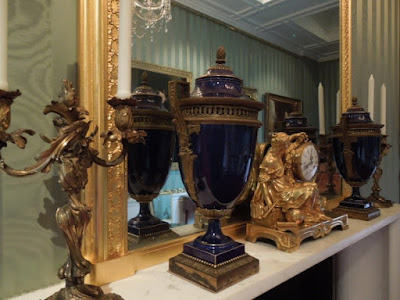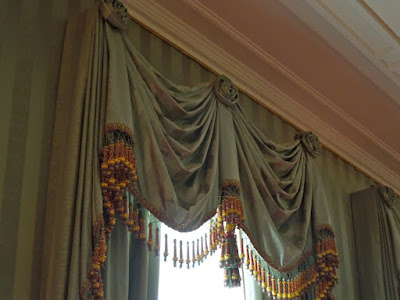Under heavy renovation and possibly finished by 2016, The Neues Palais (or new palace) in Potsdam is one of the more impressive structures in the area. Parts of Potsdam are basically a suburb of immense palaces, now nearly all museums. There are many excellent books available on the many palaces and the area itself.
The Neues Palais wasn't meant as a home for the King when it was completed in 1769 but rather as official state apartments for entertaining other royals and ambassadors. Therefore it was built to impress and not necessarily be very homey for the monarch who retained a small apartment in the palace.
Opposite the palace (above) are the Communs (seen below), creating an entry courtyard. The Communs held the kitchens, service spaces, and offices for the palace - a sort of 'downstairs' if you will. The king had underground passages built connect the Palais to the Communs so servants could get between the buildings unseen but also undeterred by weather.
The ornate interiors are astounding. Designed in the Baroque style favored by the king they're beginning to show traces of upcoming Neoclassicism. Frederick the Great didn't like the strict lines of Neoclassicism so you have to look hard though!
The palace was originally designed by Johann Gottfried Buring. Buring had completed other buildings in Potsdam for the king but was fired from the job after it was started after disagreements on the palace facade. Perhaps Buring wanted to bring in the 'new' Neoclassicm.
I don't know, I think some of the rooms look pretty Neoclassical to me, wouldn't you agree? They could have been remodeled at a later date.
The floors in the palace are stunning. The parquet floor above looks absolutely modern to my eyes.
Carl von Gontard took over construction of the palace after Buring's dismissal.
The salon above is really interesting -I love how the treatment continues to the ceiling.
Almost a sort of garden room. Also notice the modern light fixtures which are hung holding all of the modern necessities like security.
While these modern fixtures might seem strange to some, I like that they don't damage any of the delicate walls and finishes and stand separate and discreet as their own 'thing'. Europeans do this exceptionally well.
More gorgeous parquet floors, almost like fine furniture.
After awhile all of these grand rooms start to look the same; gold, gold, and more gold.
I think we need to bring back the use of bed niches.
I imagine particularly in the 18th century Germany the alcoves felt really cozy and warm before central heating.
More gorgeous painted paneling - chinoiserie here. No gold here!
The palace was later used by successive monarchs as a full time residence and it was therefore renovated with modern conveniences. I love the Victorian heat grate above.
But not all of the rooms are gold. A number of rooms are silver gilded like the bedroom below. I suppose the silver would reflect candlelight just as well if not better than the gold gilding.
As always thanks so much to my Australian penpal Neil for supplying us with these gorgeous images from his travels. If you find yourself in Berlin a visit out to Potsdam is really heavily encouraged: read more about visiting Potsdam palaces here.
The Neues Palais wasn't meant as a home for the King when it was completed in 1769 but rather as official state apartments for entertaining other royals and ambassadors. Therefore it was built to impress and not necessarily be very homey for the monarch who retained a small apartment in the palace.
Opposite the palace (above) are the Communs (seen below), creating an entry courtyard. The Communs held the kitchens, service spaces, and offices for the palace - a sort of 'downstairs' if you will. The king had underground passages built connect the Palais to the Communs so servants could get between the buildings unseen but also undeterred by weather.
The ornate interiors are astounding. Designed in the Baroque style favored by the king they're beginning to show traces of upcoming Neoclassicism. Frederick the Great didn't like the strict lines of Neoclassicism so you have to look hard though!
The palace was originally designed by Johann Gottfried Buring. Buring had completed other buildings in Potsdam for the king but was fired from the job after it was started after disagreements on the palace facade. Perhaps Buring wanted to bring in the 'new' Neoclassicm.
I don't know, I think some of the rooms look pretty Neoclassical to me, wouldn't you agree? They could have been remodeled at a later date.
The floors in the palace are stunning. The parquet floor above looks absolutely modern to my eyes.
Carl von Gontard took over construction of the palace after Buring's dismissal.
The salon above is really interesting -I love how the treatment continues to the ceiling.
Almost a sort of garden room. Also notice the modern light fixtures which are hung holding all of the modern necessities like security.
While these modern fixtures might seem strange to some, I like that they don't damage any of the delicate walls and finishes and stand separate and discreet as their own 'thing'. Europeans do this exceptionally well.
More gorgeous parquet floors, almost like fine furniture.
After awhile all of these grand rooms start to look the same; gold, gold, and more gold.
I think we need to bring back the use of bed niches.
I imagine particularly in the 18th century Germany the alcoves felt really cozy and warm before central heating.
More gorgeous painted paneling - chinoiserie here. No gold here!
The palace was later used by successive monarchs as a full time residence and it was therefore renovated with modern conveniences. I love the Victorian heat grate above.
But not all of the rooms are gold. A number of rooms are silver gilded like the bedroom below. I suppose the silver would reflect candlelight just as well if not better than the gold gilding.
As always thanks so much to my Australian penpal Neil for supplying us with these gorgeous images from his travels. If you find yourself in Berlin a visit out to Potsdam is really heavily encouraged: read more about visiting Potsdam palaces here.


















































































